If you like flowering plants but you are not very good with plants then you are absolutely right here. Because this is a list of easy to grow and easy to care for plants, that anyone can grow at home.
All of these plants are flowering plants so they will make your living space colorful and more beautiful right away.
The list is in no particular order, so I am not ranking these plants. They each have their advantages and disadvantages and they are all quite different looking. So it is completely up to you which of these plants fit your project or room the best.
1: Acalypha
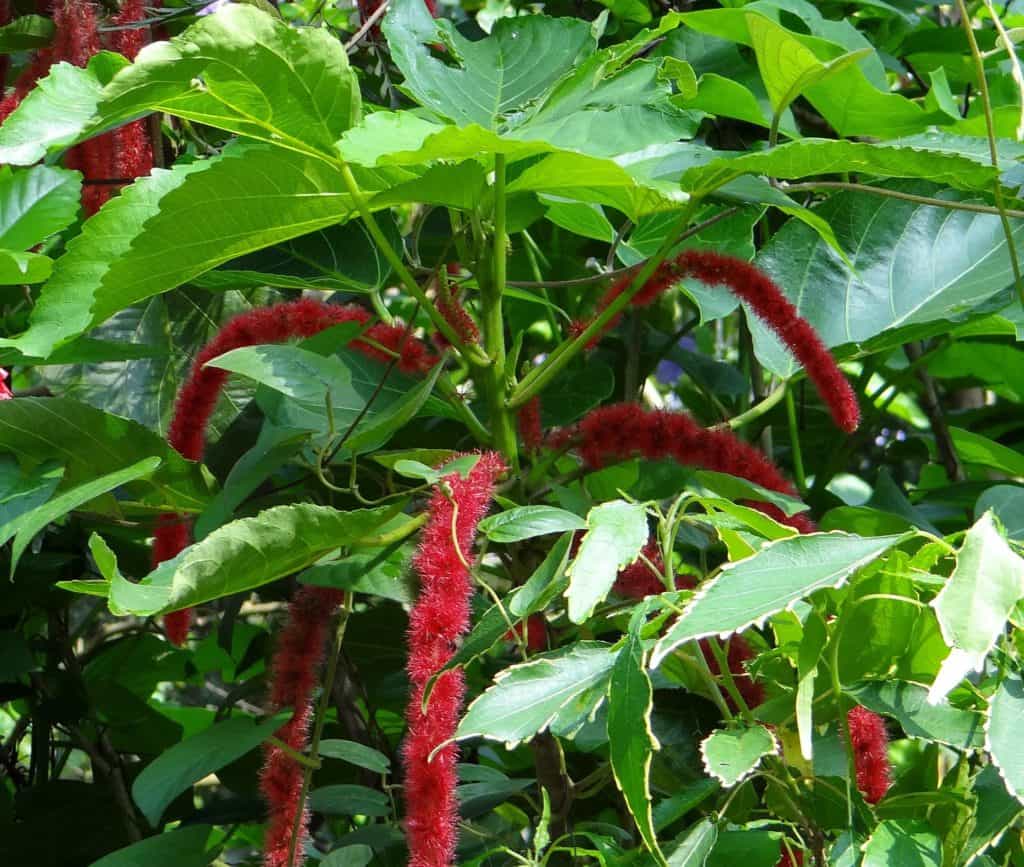
Acalypha are distinct looking plants native to Australia, New Guinea and parts of Asia.
They have large leaves with toothed margins and numerous long, drooping, fuzzy-looking red flowers called ‘catkins’ that can grow up to 18 inches in length.
Removing these flowers when they start to turn brown will encourage the plant to bloom more. The plant itself can grow to be 3 feet tall when planted indoors; as the Acalypha grows, you will want repot it into a pot one size larger until the plant is as large as you want it to be. Once that point is reached, it will be necessary to aggressively prune back the growth to keep it from over-expanding.
A majority of the Acalypha species can withstand fairly extensive pruning and will still thrive, even with up to a quarter of the plant’s foliage removed.
Acalypha needs a well-drained potting mix and their soil needs to be kept moist to the touch.
Feed these plants a diluted, water-soluble fertilizer regularly.
They grow best when kept at temperatures above 60 degrees Fahrenheit, and need lots of bright, direct light during the growing periods. The plant will have a natural dormancy cycle in the winter but will resume growing again in the spring.
The sap of Acalypha is toxic, and can be mildly irritating to skin. The leaves should not be ingested.
2: Africa Violet
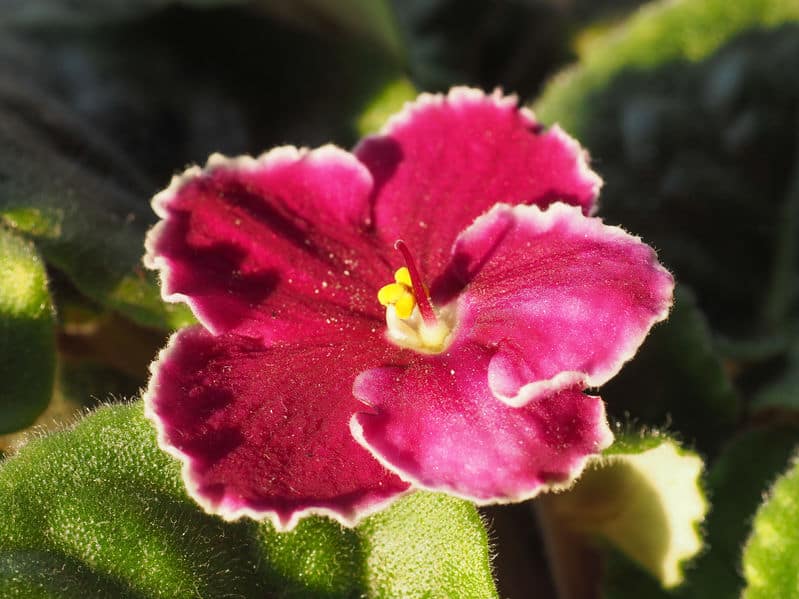
The African Violet, originally of Tanzania, is a charming houseplant thanks to its wide, fuzzy leaves and purple, pink, blue, or white flowers.
Removing the flowers when they start to fade will result in more flowers blooming.
African Violets come in a wide range of varieties and sizes, from 6 inches to 16 inches. The large varieties require a pot at least 6 inches in diameter; standard varieties require a pot 4 inches in diameter; semi-miniature variates require a pot 3 inches in diameter, and miniature varieties require a pot 2 inches in diameter.
Because violets grow out more than up, most varieties only reach 3 to 6 inches in height.
African Violets like loose soil; bags of soil blended specifically for Violets can be easily purchased, or you can make your own by mixing equal parts perlite, peat moss, and vermiculite.
They like their soil to be kept slightly moist, and will not respond well to soil that is fully wet or completely dry. Water them with room-temperature water under the leaves to avoid spotting and leaf rot.
A fertilizer specially formulated for African Violets can be purchased and should be given to them regularly.
African Violets like warm places, so keep them away from windows and doors during cold months. They grow best in medium to bright lighting; darker green plants require more light, pale and medium green plants require less.
3: Amaryllis

Amaryllis are plants native to Peru and South Africa, with the large bulbs commonly given as gifts in the winter.
It grows 4 to 10 inch wide trumpet-shaped flowers in a multitude of colors; the most common are red and white, though flowers may also be pink, salmon, apricot, rose or deep burgundy.
The Amaryllis grows a stalk 18 to 36 inches tall that the flowers bloom from the top. Remove the flowers when they start to fade and cut the stalk to within 1 inch of the bulb, but allow the plant to continue growing leaves as this will increase the chances of healthy blooming in the next year.
Amaryllis require a heavy 6 to 8 inch pot to prevent them from falling over, as they can be rather top-heavy.
They will grow well in normal potting soil with good drainage, though the soil must be kept moist. Fertilize Amaryllis at half the recommended strength when new growth is visible; fertilizer high in phosphorus will improve their flowers.
These plants prefer bright indirect light, and once blooming has concluded they should be placed in the sunniest location possible.
In mid-August begin withholding water from the plant and let the foliage die back naturally. Keep the bulb in a cool, dark place for at least eight weeks, though the plant can survive in its dormant state for longer than that.
6 to 8 weeks before you want the Amaryllis to bloom again, repot the bulb in fresh potting soil and put it back into bright, indirect light. Resume watering, though only a little; when you see new growth on the plant, increase watering to keep the soil moist once again.
The Amaryllis will bloom again in four to six weeks. Amaryllis are toxic to animals.
4: Angel Wing
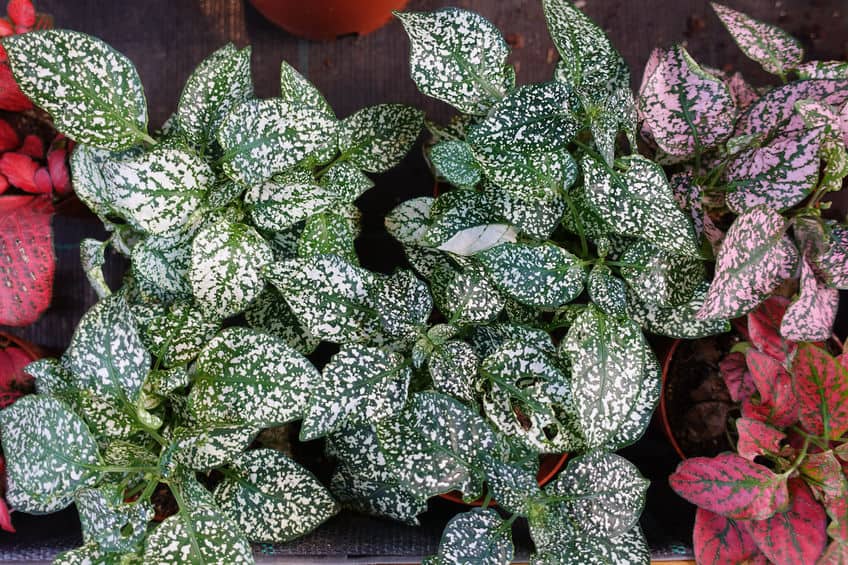
Angel Wing Begonias are stunning South American plants with large, dark green leaves marked with metallic-looking flecks or reddish undertones and clusters of hanging white, orange, pink, or red flowers.
Angel Wing Begonias range in size from dwarf desktop plants to 5 foot tall bushes depending on the variety and care given to the plant. They grow best when repotted yearly in the spring, moving to a slightly larger pot each time.
They prefer airy, fast-draining soil; African Violet soil works well for them. Angel Wing Begonias like damp, but not wet, soil; when the first inch of soil in small pots or first 2 inches in large pots is dry, rewater.
Feeding these plants phosphorus-rich fertilizer will help them flower. These plants grow best in moderate temperatures, though they do not like cold drafts. The lighting needs of Angel Wing Begonias depends on what you’re looking for from the plant.
To focus on the large, beautiful leaves, it is best to keep them in low light, as this will discourage blooming. If flowers are your goal, place the plant in bright, indirect light. Consuming this plant is toxic to children and animals.
5: Bird of Paradise
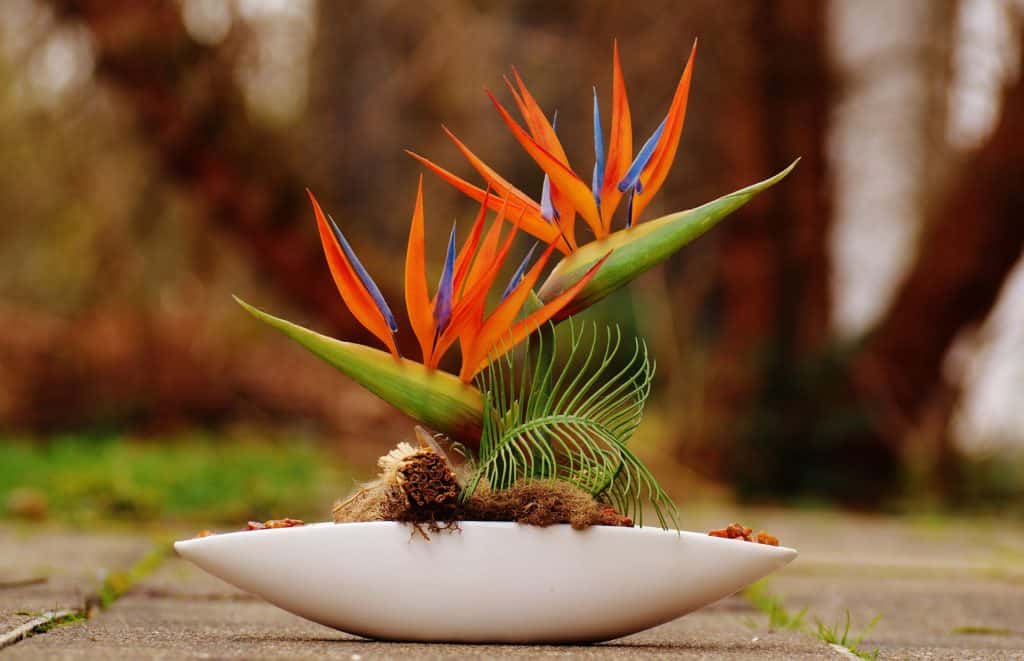
Bird of Paradise is a very large tropical south African plant with beautiful spiky orange and blue flowers. Large is not an exaggeration – these plants grow to be 5 to 6 feet tall.
They will need to be repotted as they grow; 3 to 4 foot plants should be in 8 inch pots, while 5 to 6 foot plants will be more comfortable in 14 inch pots.
Bird of Paradise needs rich, well-draining potting soil that is kept moist throughout the spring and summer. During the plant’s dormant winter period they need less water, only about once a month; wait until the top 2 inches of soil is dry before watering.
You can use an all-purpose liquid fertilizer once a month during the spring and summer to keep this plant healthy.
Bird of Paradise love humidity, and they grow best in temperatures between 65 degrees Fahrenheit and 75 degrees Fahrenheit though they will tolerate slightly lower temperatures during their dormant period in the winter.
These plants like 6 hours of bright sunlight, and will accept direct light during a portion of the day.
Something to note is that a Bird of Paradise will not bloom until it is 3 to 5 years old. These plants cannot be pruned so they need to have large space to grow. Bird of Paradise are toxic to animals.
6: Brazilian Firework
Brazilian Firework Plants are striking South American plants with long, silver-veined leaves and vibrant pinkish-red and purple flower clusters.
These plants range from 6 to 18 inches in height and 12 to 24 inches across.
They can happily live in pots 4.5 to 8 inches across, depending on the size of the plant. Brazilian Firework Plants can be grown in typical potting soil, though they prefer it to be aerated, and they should be given a liquid fertilizer high in potassium once a month.
As with most indoor plants, Brazilian Firework Plants like moist but not wet soil.
These plants love humidity and warm temperatures and grow best in those conditions. Avoid direct light, as these plants prefer partial to full shade.
7: Bromeliads
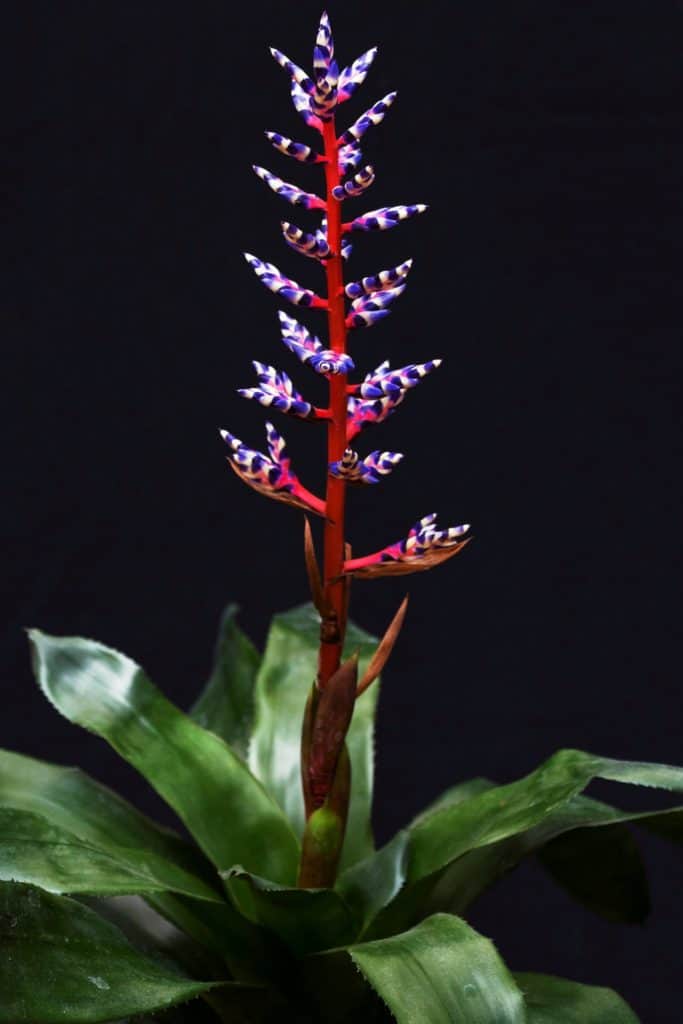
Bromeliads come in a large number of varieties from many locations across the world. The most common Bromeliads often have beautiful red, green, purple, orange, yellow, banded, striped, or spotted leaves. They also grow pink, red, orange, yellow, purple, or white flowers.
These plants range in size from 1 inch to 30 feet, so pot size will vary as well.
Small Bromeliads should be comfortable in 3 to 4 inch pots, with medium plants needing 5 to 6 inch pots.
They should be planted in commercial potting soil mixed with perlite, peat, or sand with crushed stone at the bottom of the pot.
Bromeliads can be watered by filling the cup at the base of the leaves, and they should be given half-strength fertilizer once a month during the growing season.
The pot can be placed raised in a dish of water to provide the Bromeliad with more humidity, which they like.
These plants are tolerant of temperature ranges of 60 degrees Fahrenheit to 80 degrees Fahrenheit, and grow best in medium to bright light – plants with soft leaves prefer medium light, while plants with hard leaves should have bright light.
Bromeliads flower for 3 to 6 months; after that, they put out ‘pups’, which are baby plants. These plants can be removed when they are 1/3 the size of the mother plant, and replanted to grow and eventually bloom on their own.
8: Calamondin Orange
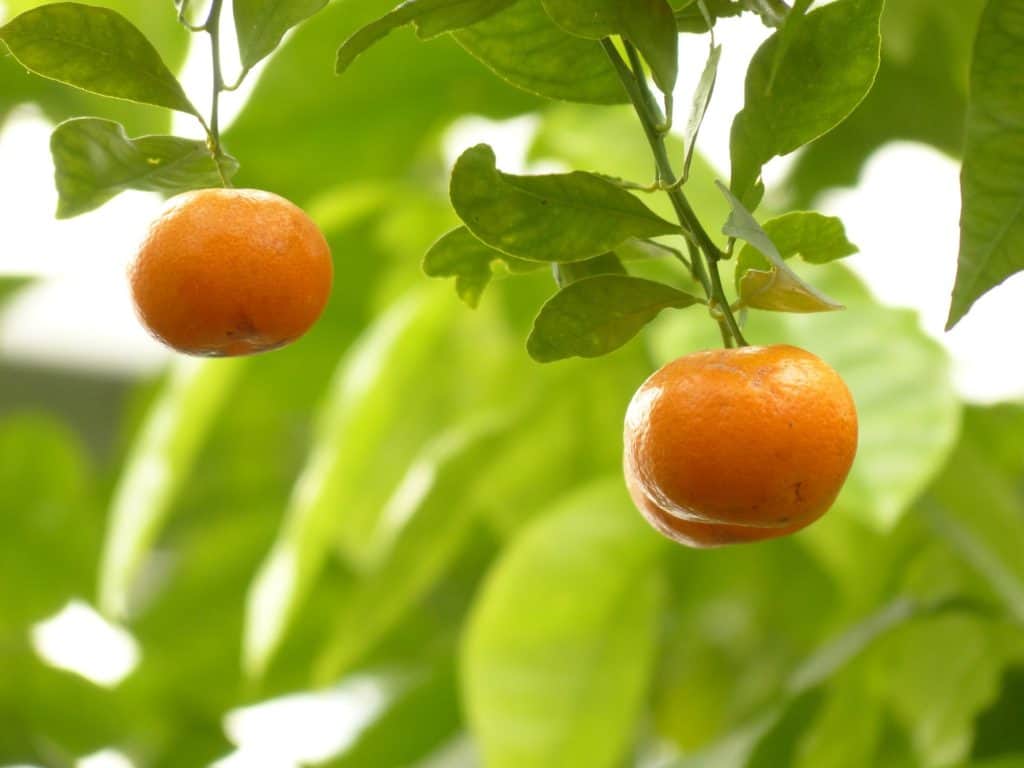
The Calamondin Orange is an adorable miniature orange tree from China. This tree sports fragrant, star-shaped white flowers and fruit at the same time.
The oranges can be eaten, though they are small, acidic, and tart – rather like a lemon.
Calamondin Oranges grow to a height of 3 to 4 feet; they should be kept in a 6 inch pot until the tree is 3 or 4 years old, then moved to an 8 inch pot.
This plant grows well in a peat moss-based potting mix with added perlite and/or vermiculite.
It should be kept on a tray of wet pebbles and be misted regularly to keep the plant humid and happy. Water well and let the surface of the soil dry in between waterings.
Fertilizing with a citrus formula, or formula for acid-loving plants, in the spring and summer will help keep this tree healthy. During the fall and winter, halve the amount of fertilizer used. Calamondin Oranges thrive with as much direct light as possible.
If you want the fruit to grow, you will need to pollinate the flowers yourself. The process is a simple one: use a small, dry paintbrush to dab the center of each flower. Wiggle the brush around to pick up pollen, moving from flower to flower until all the flowers have been pollinated. Calamondin Orange trees are toxic to animals.
9: Cape Primrose
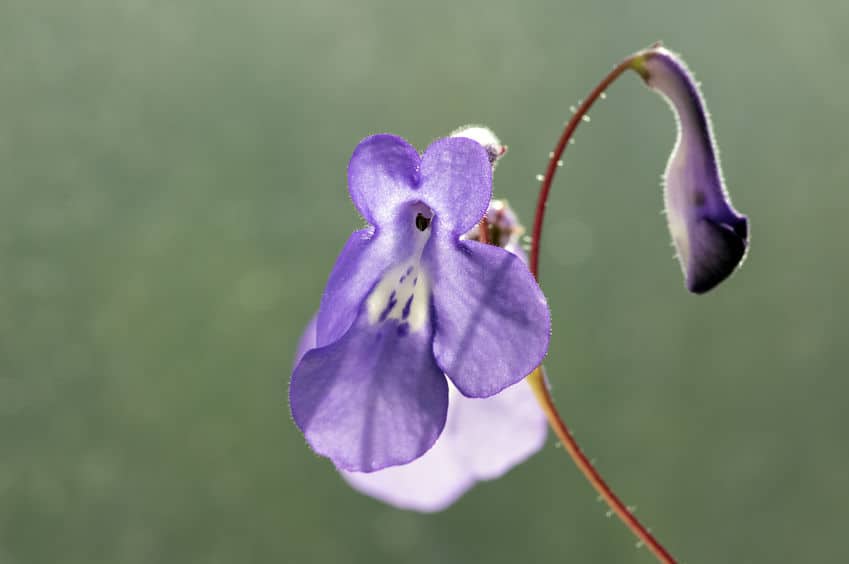
Cape Primrose is a South African plant, with tall flower stems and clusters of 1 to 3 inch wide trumpet-shaped flowers in shades of purple, violet-blue, pink, red, lavender, or white.
This plant grows up to 1 foot tall with an 18 inch spread. They should be planted in 4 to 6 inch pots, and grow well in African Violet soil.
It is important to keep the soil damp, but not wet. Use a balanced fertilizer at half the strength to feed this plant, though it is important to periodically let the water run out of the bottom of the pot to flush away any built-up salts.
Misting the leaves will keep a Cape Primrose happy, and it needs a lot of indirect light to flourish.
10: Christmas Cactus
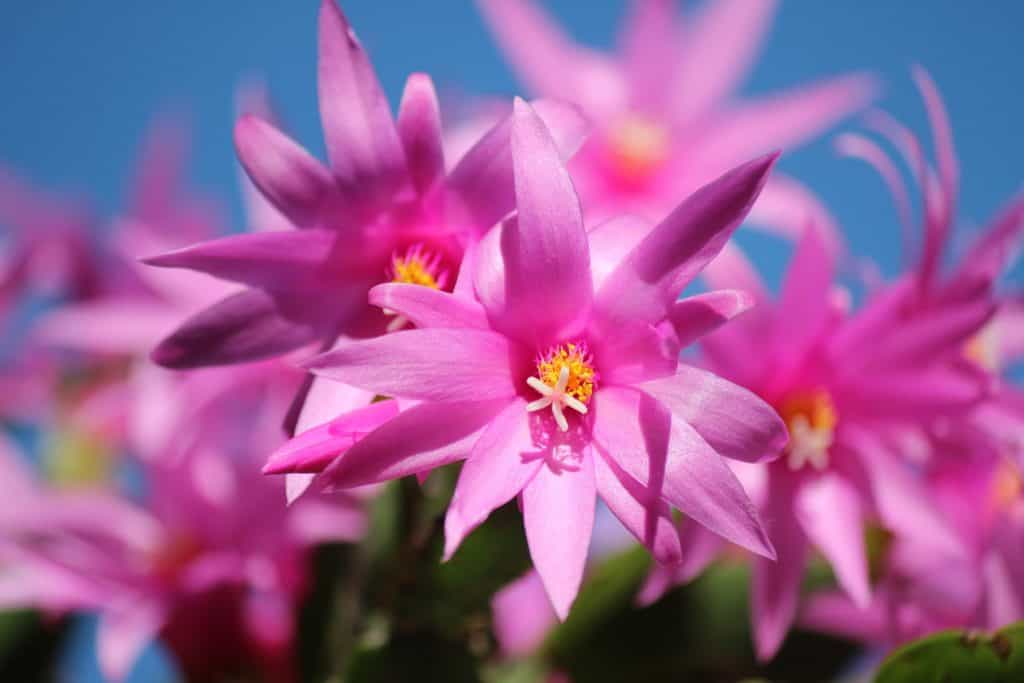
Christmas Cactus is a well-known Brazilian plant, so-called because it blooms in the winter around Christmastime.
Tiered, three-inch-long flowers can be red, white, yellow, pink, or purple and appear at the tips of the arms of the plant.
Christmas Cactus grow to 6 to 12 inches tall and can be 3 feet wide.
They grow well in a 6 to 8 inch pot filled with sandy, loamy soil that is kept damp but not wet.
A fertilizer high in potassium should be applied to the plant every two weeks once buds form. While Christmas Cactus like bright, indirect light, they also need 14 hours of darkness at night to trigger flowering.
11: Clivia
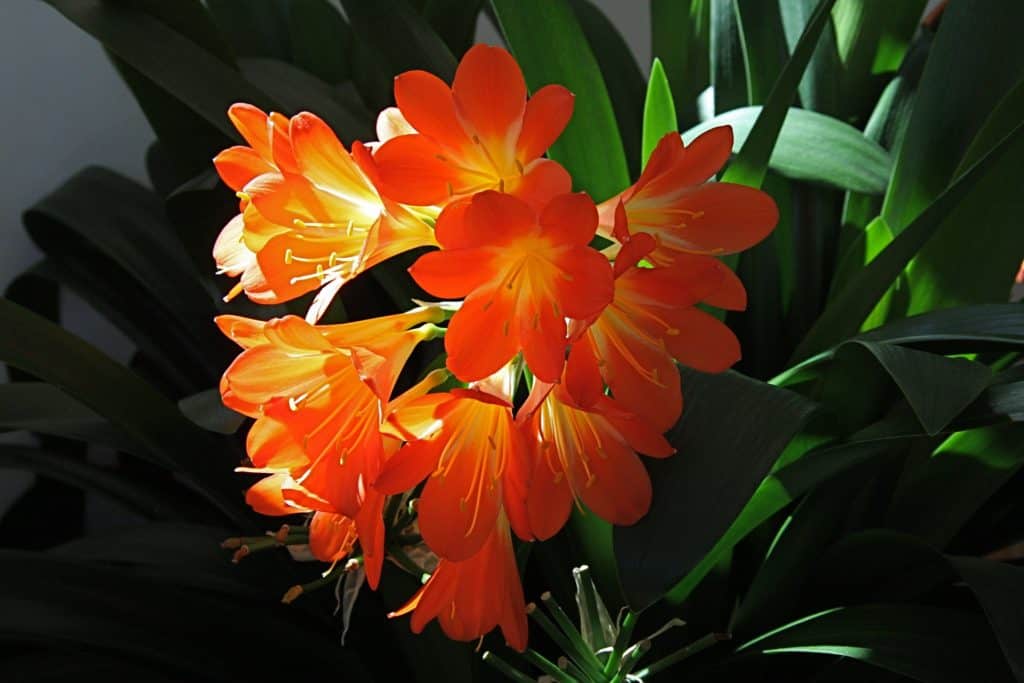
Clivia are eye-catching plants from South Africa, with long, graceful leaves and clusters of trumpet-like orange or yellow flowers.
Clivia grow to be 2 to 3 feet tall and almost 2 to 3 feet wide, so it is important to use heavy pots so that the plant won’t topple.
This plant does not need to be repotted often; they can go three years or more before they need an upgrade. When it is repotted, use a pot two inches larger than its previous pot to give it some more room to grow.
Clivia like fast draining peat and sandy soil.
They need less water than many other houseplants; after it is well watered, you can wait until the top half of the soil is dry before it needs to be watered again. In the winter, move the Clivia into a cool area for about six weeks and stop watering. This will let it rest and ready itself for the next season’s flowers.
After the six-week dormancy is over, move the plant back into a bright, warm area, resume watering, and feed it with a high-strength fertilizer high in potassium. Clivia grow best in bright, indirect light or shade. Clivia are toxic to animals.
12: Crown of Thrones
Crown of Thorns is a striking plant from Madagascar with red, pink, peach, or yellow bracts, which are modified leaves, around small flowers. The stems of the plant sport half-inch long thorns.
They will grow to be 3 feet tall and 2 feet wide. Young plants will grow well in 6 to 8 inch pots; when repotting, go up one size each time.
Crown of Thorns grow well in cactus soil. The top 2 inches of soil should dry between waterings. Half-strength fertilizer high in phosphorus and low in nitrogen given monthly will keep your Crown of Thorns happy, healthy, and blooming.
These plants like bright, direct sunlight.
The sap of Crown of Thorns is toxic to animals.
13: Cyclamen
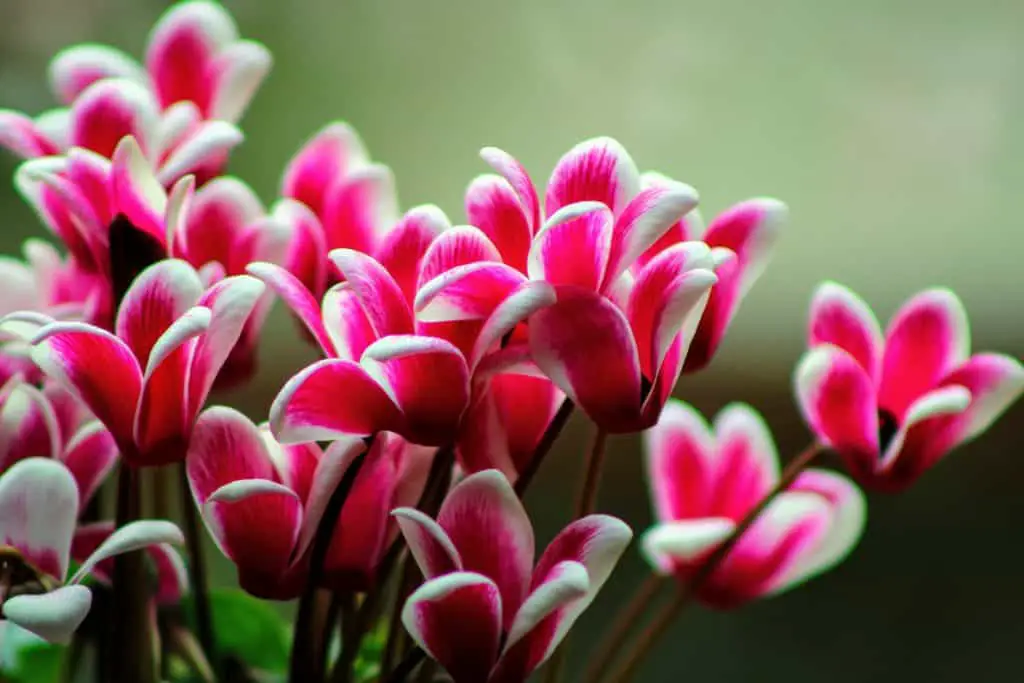
Cyclamen is a cheery plant from North Africa and the Mediterranean, with silver marbled leaves and upright 1/2 to 3/4 inch red, white, pink, or lavender flowers.
When in bloom, these plants stand only 8 inches tall, so they are very comfortable in 3 to 6 inch pots.
Cyclamen should be planted in rich, well-draining soil.
These plants are sensitive to both over and under watering; water when soil is just dry to the touch, but not dried through.
Using half-strength fertilizer every month or two will keep the plants healthy.
Once the flowers begin to fade in late spring, cut back on watering and allow the plant to dry out in a cool, dark place for two to three months. They will look dead, but don’t worry – the plant is just dormant.
When new growth appears, move the Cyclamen to a bright, sunny location with indirect light and resume watering. Cyclamen are toxic to animals.
14: Flowering Kalanchoe
Flowering Kalanchoe is a vibrant, long-lasting African succulent.
This plant has large, fleshy leaves and is topped with large clusters of small yellow, pink, magenta, orange or red flowers. They grow to be 12 inches tall and will be comfortable in 8 inch wide pots.
Flowering Kalanchoe grows well in a half potting soil half cactus soil mix; they should be watered well every 2 weeks or when the soil feels dry.
They are happy in moderate temperatures and with bright, indirect light.
Flowering Kalanchoe is toxic to animals.
15: Flowering Maples
Flowering Maples are large plants native to South and Central America. Its distinctive leaves strongly resemble those of Maple trees, earning it the name despite not being related to Maples.
The flowers of the Flowering Maple are 3 inch wide, shaped like hanging bells, and come in pink, red, white or yellow. These plants grow to be 2 to 5 feet tall and need regular pruning to keep under control.
Young plants should be repotted every 6 months as they grow, but older plants can go a year or two without need for repotting.
A peat-based soil mix with low acidity works well for Flowering Maples. During growth periods water the plant and give it diluted fertilizer when the soil 1 inch deep is dry, but cut the watering down to once a month and cease fertilizing during the winter.
Flowering Maples are happy in moderate temperatures and they love getting a few hours of direct sunlight.
16: Geraniums

Geraniums are popular plants from South Africa. This plant has distinctive scalloped leaves and sports several bunches of pink, salmon, red, purple or white flowers on long stems. Geraniums range in size from 6 inches to several feet tall.
Many varieties of the plant will be happy in a 10 inch pot, but some smaller varieties can thrive in a 6 to 8 inch pots.
These plants grow best in well-draining potting soil.
Water Geraniums when the top inch of soil is dry, though they will need slightly less water in winter. During the active growing months in the spring and summer, add some half-strength, water-soluble fertilizer.
It is not necessary to fertilize in the winter months. Geraniums bloom best during times of warm days and cooler nights.
These plants like full sun in the morning with shade in the afternoon.
Geraniums are toxic to animals.
17: Gloxinia

Gloxinia is showier cousins of African Violets, native to Brazil. These plants have the same fuzzy leaves as Violets, though their flowers are larger, cup-shaped, and come in white, pink, red, purple, or blue.
Gloxinia can grow to 6 to 12 inches and are comfortable in 4 to 6 inch pots.
They grow well in African Violet soil, which must be kept moist.
Fertilize Gloxinia during the growing season with liquid fertilizer.
These plants like moderate temperatures and bright, indirect light. It is common to discard Gloxinia when they finish blooming, as they will not bloom as well in subsequent years.
18: Goldfish Plants
Goldfish Plants are whimsical plants from Mexico, Costa Rica, and Brazil. Scattered among the long, waxy leaves are red, orange, or yellow flowers that resemble fish, giving the plant its name.
Goldfish Plants bloom best when kept under 2 feet high; the long, hanging vines of the plant can reach 3 feet if not pruned back.
They grow best in 6 or 8 inch pots filled with African Violet soil.
This soil should be kept moist, though it can be allowed to dry slightly more between waterings during the winter.
Goldfish Plants should be fed a weak liquid fertilizer that includes micronutrients and encourages blooming weekly during the growing season. These plants like lots of bright, indirect light.
19: Hibiscus
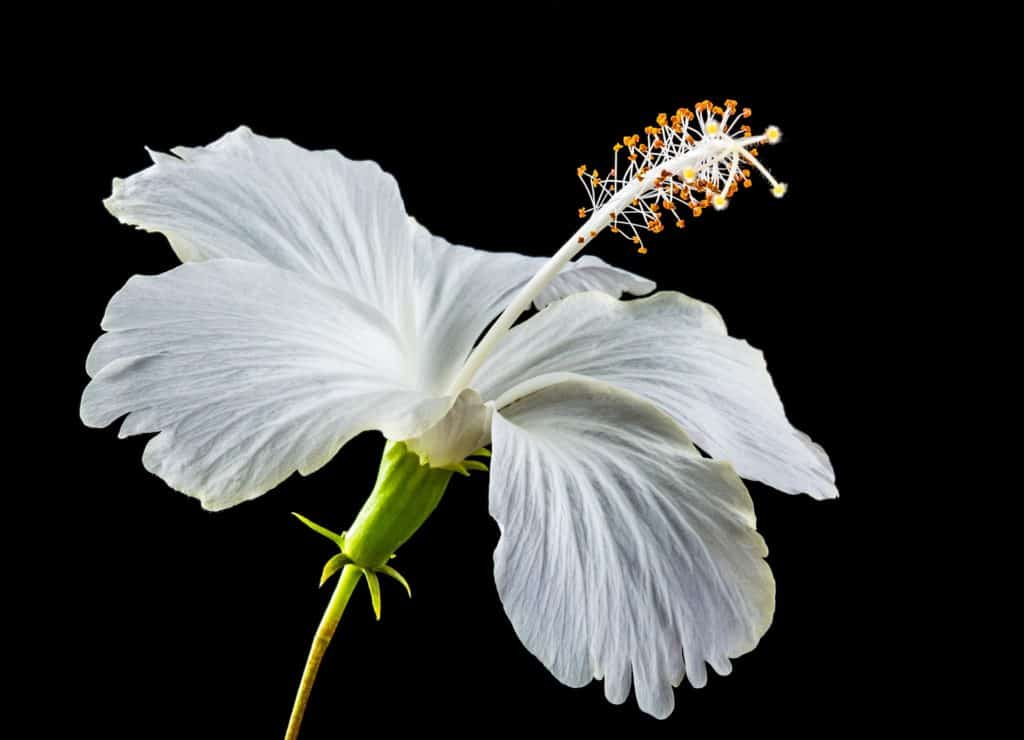
Hibiscus are well-loved tropical plants, with bright red, pink, orange, yellow, or white flowers that can be between 2 and 10 inches across when in full bloom. Hibiscus will grow to 6 feet tall if not pruned back, so it needs attention to keep it from getting out of hand.
This plant has wide root balls, so they need wide pots; a 10 inch pot is suitable for young plants. When repotting, choose pots a few inches in diameter larger than the current pot.
These plants grow well in lightweight, well-draining potting mix. When the Hibiscus is actively growing in the spring and summer months it is important to keep the soil moist, but never soggy.
In the fall and winter, the top 2 inches of soil can dry before watering is needed. Feed this plant a slow-release fertilizer in the early summer, or with a liquid, blooming fertilizer weekly.
Hibiscus can be grown in moderate temperatures, but they should never be in temperatures below 50 degrees Fahrenheit. If you place your Hibiscus outside in the summer, it’s a good idea to place it in the shade for about two weeks to allow it to adjust to being outside before moving it into bright sunlight.
During the winter, give Hibiscus as much direct light as possible.
20: Impatiens
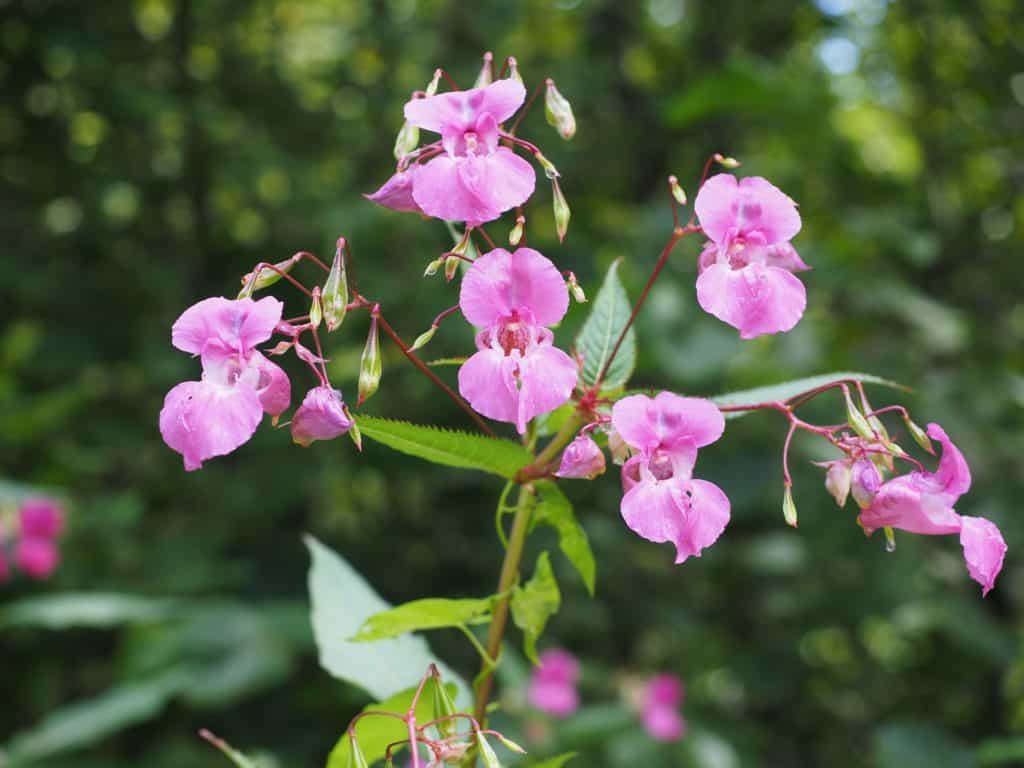
Impatiens are a variety of bright plants from Africa, Eurasia, and North America. They grow numerous pink, red, lilac, purple, orange, white, or bi-colored flowers; cutting off spent flowers will encourage the plant to produce more blooms.
Impatiens can become 12 inches tall and are often grown in clusters in 7 or 8 inch wide pots; plants placed closer together will grow taller than those spaced out more.
These plants like rich, well-draining potting mix that is kept moist.
Impatiens should be fed a half-strength, high-phosphorus, water-soluble fertilizer every 2 weeks from spring through fall.
They should be placed where temperatures will not drop below 55 degrees Fahrenheit. Impatiens will tolerate low light conditions, but grow best in sunny, indirect light.
21: Jasmine
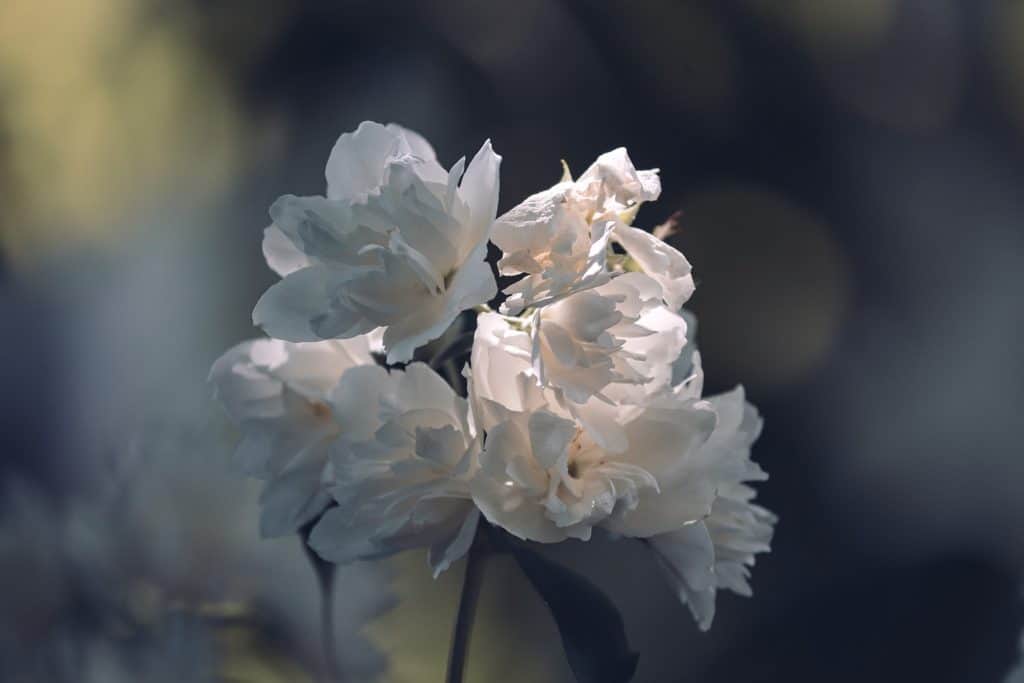
Jasmine is a plant with strongly fragrant flowers from the tropical and warm temperate regions of Eurasia and Oceania. This plant grows long, climbing vines with star-shaped white, yellow, or pink flowers. The vines can reach 6 feet in length, but the plant looks better with the vines pruned to shorter lengths.
Jasmine should only be repotted when its roots have filled the pot it is in, generally every 3 years.
They grow well in standard peat-based or coir-based potting soil with added drainage material.
This soil should be kept moist but not wet. Feed Jasmine weak houseplant fertilizer the growing season. Giving Jasmine fertilizer high in phosphorus will prolong the length of blooming.
Jasmine should be kept in cooler places during the winter, as this will trigger the plant to start flowering. In the summer months, give it access to bright, indirect light.
22: Lipstick Plants
Lipstick Plants are unique-looking plants originally from Indonesia. This plant has waxy leaves and 3 inch long tube-shaped red and maroon flowers.
Lipstick Plants will grow 8 to 12 inches, with long vines. These vines should be pruned to desired length to prevent them getting out of hand. Lipstick Plants should be put in smaller pots rather than larger; this encourages flowering. Lipstick Plants grow well in African Violet potting soil; allow the top quarter of the soil to dry before watering as it will also encourage flowering.
If the leaves of the plant seem shriveled, the plant needs more water. Lipstick Plants should be fed a fertilizer high in phosphorus every other week in the spring and summer and monthly in the fall and winter to help them look their best.
These plants like warmth and humidity, and should be placed in very bright indirect light for a portion of the day.
23: Oxalis
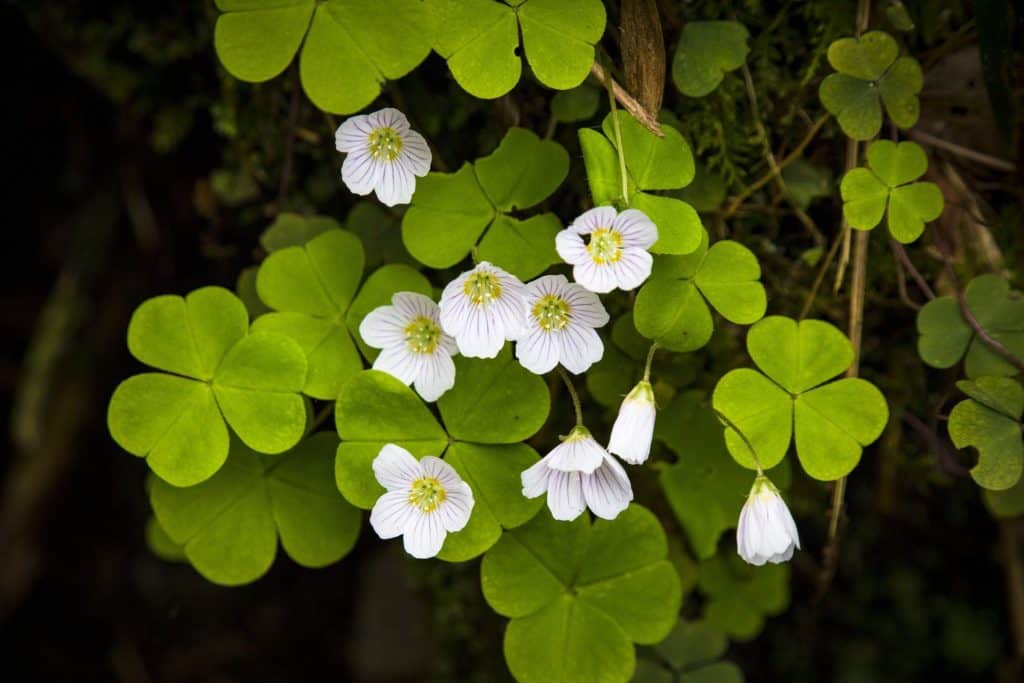
Oxalis is a plant native to North America. It has large green or purple shamrock-shaped leaves that close at night and delicate white or lavender flowers.
As Oxalis only grows to 6 inches in height, they are perfect for small pots.
These plants like loose and sandy soil, kept barely moist. The top 2 inches of soil should be dry before the plant is watered again. Oxalis should be given a half-strength, balanced fertilizer monthly during the spring and summer when the plant is actively growing.
Oxalis likes cool temperatures and bright, indirect light.
After the plant blooms, the leaves will turn yellow and droop, usually in the late fall. Despite looking like the plant is dying, the Oxalis is only entering a dormant state. Stop watering and move your plant to a cool, low-light area.
Green leafed Oxalis need to rest for 2 to 3 months; purple-leafed Oxalis need only about a month of rest. After your plant has rested, it can be moved back into bright, indirect light and watered as normal.
When new growth appears, resume fertilizing.
Be aware that Oxalis may go dormant several times a year.
This plant is toxic to animals.
24: Parodia Cactus
Parodia Cactus are surprising little South American plants. The size of the Parodia Cactus varies by the specific type. These plants grow large yellow, red, orange, or pink flowers from the crown of the cactus.
Parodia Cactus should be given an inch of space between the cactus and the edge of the pot they are placed in. They grow well in rich, fast-draining cactus mix.
While the soil should be kept moist in summer, the soil should be allowed to become mostly dry between waterings during the winter. When Parodia Cactus are in the growing season, fertilize the plant with a cacti fertilizer mix.
Placing the Parodia Cactus in a cooler location in the winter will encourage flowering. During the spring and summer, Parodia Cactus can have direct morning sunlight and indirect light the rest of the day.
25: Peace Lily
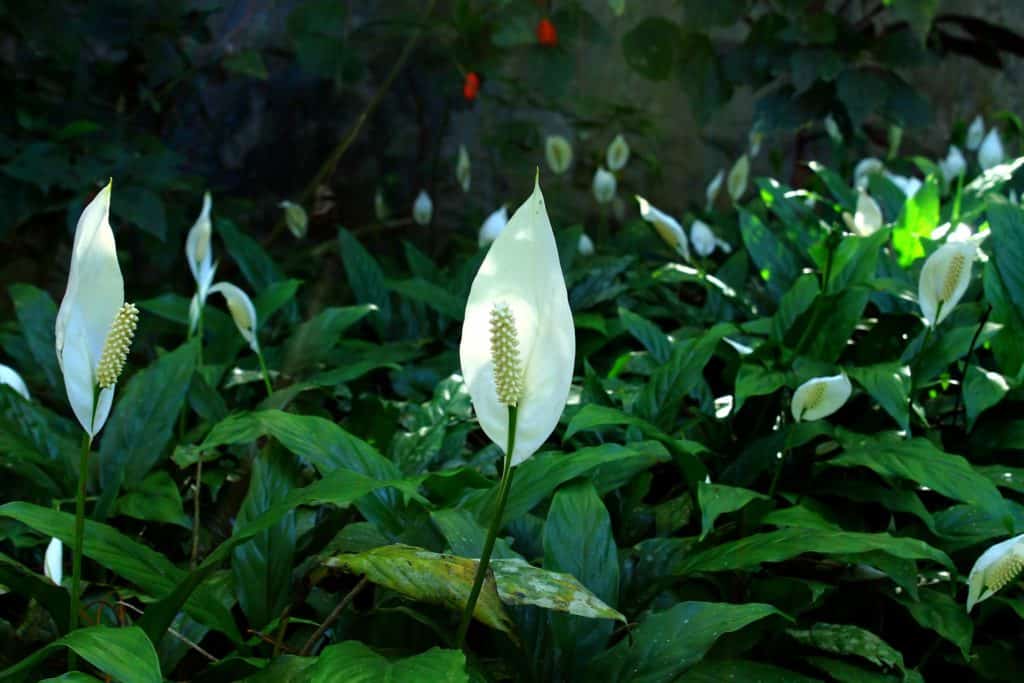
Peace Lily are commonplace plants native to tropical areas of the Americas and Southeast Asia.
Peace Lily grow large, dark green leaves and white ‘flowers’ (the white portion is a modified leaf called a bract). These plants grow 16 inches to 3 feet depending on the specific variety. Peace Lily should be kept in 6 to 8 inch pots.
They like well-aerated soil with peat; water them when their soil is dry to the touch.
Take care not to over-water. Peace Lily like to be given balanced fertilizer one to two times per year.
They grow comfortable in temperatures ranging from 65 degrees Fahrenheit to 85 degrees Fahrenheit and respond well to medium light.
Peace Lily are filtering plants, removing toxins from the air including benzene, formaldehyde, trichloroethylene, xylene, and ammonia.
This plant is mildly toxic to animals and children.
26: Poinsettia

Poinsettia is an iconic winter plant from Mexico. Their tiny yellow flowers are surrounded by large, bright red modified leaves called bracts. Poinsettia comes in a variety of sizes though typical plants sold in 4-inch pots are 10-12 inches tall.
These plants like quick-draining acidic soil, and need watering when the top half of soil is dry.
Poinsettia prefers to be kept in 65F to 70F temperatures, away from drafts and heat sources. They respond well to very bright indirect light. Most people discard Poinsettias after they finish blooming.
If the Poinsettia is kept longer than one season, relocate the plant to a cool, dark area until spring and decrease regular watering to allow the plant to dry out some, but not completely. In the spring, the Poinsettia can be returned to its place in the sun and be watered as normal.
Feed the plant half-strength fertilizer every three to four weeks during the spring.
Prune back the plant to about six inches from the rim of the pot. When the Poinsettia’s growth reaches six to ten inches it should be pinched back to encourage branching, resulting in a fuller-looking plant.
Poinsettia need 12 hours of darkness a night during September through November to encourage its winter blooming.
27: Reiger Begonia
Reiger Begonia is a hybrid, created from tropical plants. It grows creamy, beautiful, bright flowers in yellows, reds, pinks, and white.
This plant grows to be 18 inches tall and 10-12 inches wide, and should only be repotted if it outgrows its current pot.
Reiger Begonia grow well in African Violet soil; water when the top half of the soil is dry. Fertilize the plant once a month with a high-phosphorus liquid plant food while in flower.
When the Reiger Begonia stops flowering, stop feeding the plant and gradually reduce the amount of water it is given until the soil is barely moist.
Reiger Begonia like cool temperatures and medium to bright light; the better the light, the better the flowers the plant will produce. Like many other plants, the Reiger Begonia needs dark nights to encourage blooming.
Once the plant flowers, try not to move it. Reiger Begonia is toxic to animals.
28: Shrimp Plant
The Shrimp Plant of Mexico, Guatemala, and Honduras is an interesting and unique looking plant, with bright yellow, pink, or red overlapping bracts that resemble shrimp tails.
This plant can grow 1 to 3 feet tall, and can be grown as a bush or a tree shape.
Shrimp Plants should be kept in 6 inch pots with fast-draining potting soil that is kept moist. Feed this plant weekly with a weak liquid fertilizer. Shrimp Plants like cool temperatures, 60F to 75F, and bright, indirect light.
Prune this plant hard in the spring to keep it under control.
29: Spiderwort
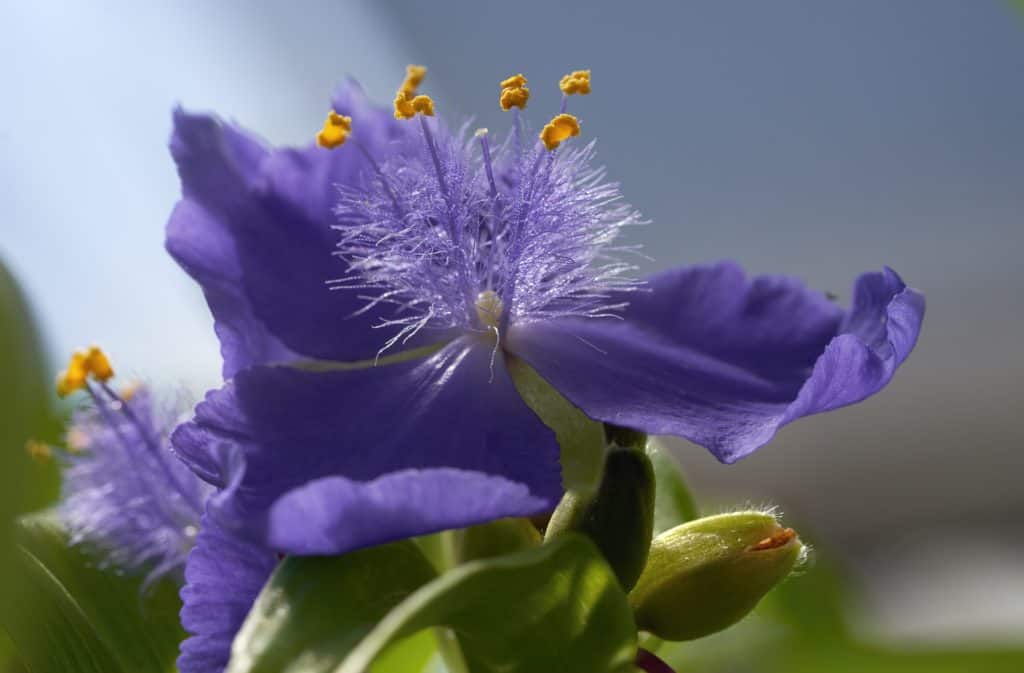
Spiderwort is a notable plant from Mexico, South America, Central America, and the Caribbean. It has white, green, silver, and purple striped leaves, with small pink, rose-purple, or white flowers.
While Spiderwort only grows 6 to 9 inches in height, its vines can grow to 6 feet in length if not kept under control.
Spiderwort only needs repotting to larger spaces as needed.
It grows well in regular potting soil, and should be kept moist with weekly watering in the summer; the plant needs less water in the winter. Spiderwort should be fed monthly with a half-strength liquid fertilizer.
This plant thrives in 65 degrees Fahrenheit to 75 degrees Fahrenheit temperatures, but can tolerate warmer. Keep Spiderwort in bright, indirect sun. Pinching back the vines will encourage fuller growth of the plant.
30: Wax Begonia
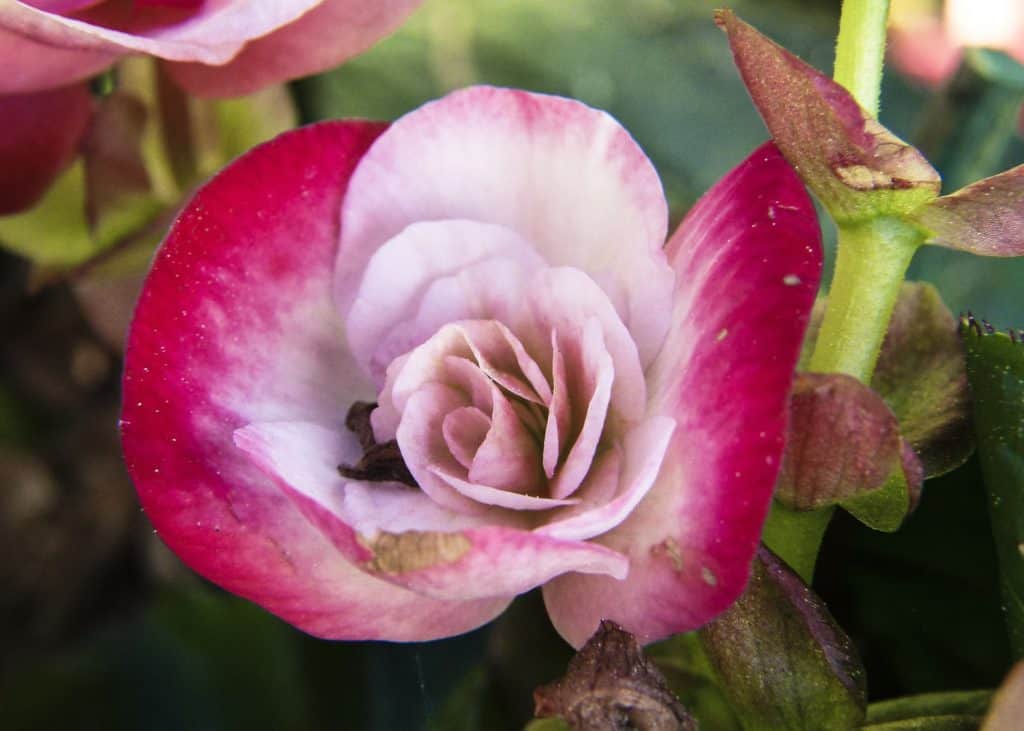
Wax Begonia is a popular garden plant from South America that also grows well indoors. This plant grows numerous small white, pink, or red flowers.
Wax Begonia range in size from 6 inches to 2 feet; they should grow happily in 6-inch pots filled with light, well-draining soil.
The soil should be kept moist. Wax Begonia should be given quarter strength liquid fertilizer weekly or half-strength fertilizer biweekly.
Every third or fourth feeding, use a high phosphorus fertilizer to encourage flowering.
Wax Begonia is happy in temperatures up to 75 degrees Fahrenheit and like bright, indirect light.
Wax Begonia is toxic to animals.
